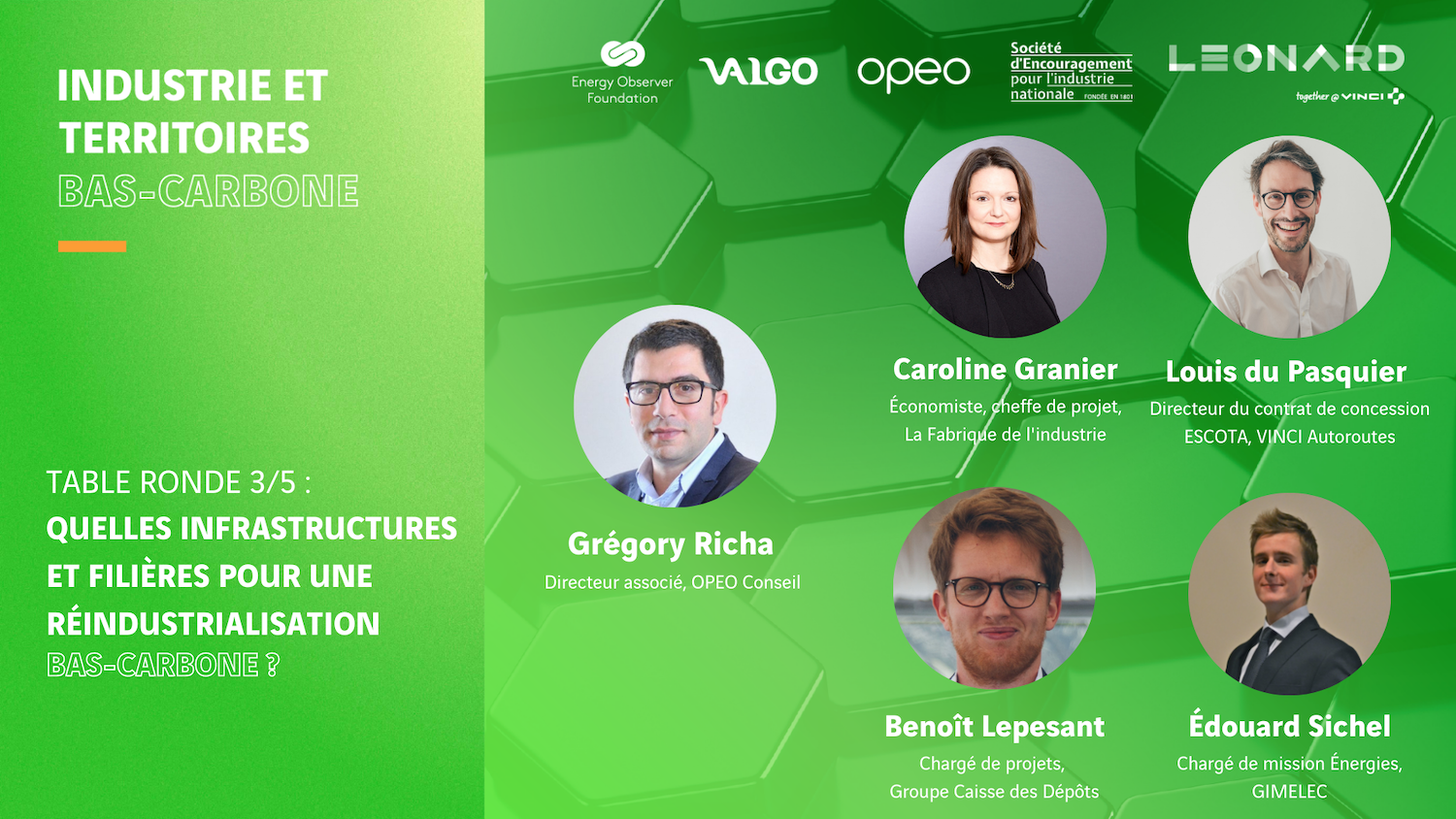The third meeting in this series, which took place on 20 April, focused on the infrastructures and sectors necessary for low-carbon reindustrialisation. Moderated by Grégory Richa, associate director of OPEO Conseil, the conference brought together Caroline Granier, economist and project manager at La Fabrique de l’industrie, Louis du Pasquier, director of the Escota concession contract at VINCI Autoroutes, Benoît Lepesant, project manager at the Caisse des Dépôts Group, and Édouard Sichel, energy project manager at GIMELEC.

They are a key factor in the competitiveness of territories. Infrastructures, which cover all fixed equipment dedicated to the transport of people, goods, water, gas and electricity, are also a major building block in the reflection on the energy transition. There can be no decarbonisation of industry without the development of cleaner infrastructures. Public authorities and industrial sectors must play their part if they want to accelerate the transformation of processes and uses.
The strategic choices for the deployment of these infrastructures are crucial. For, as Caroline Granier, project manager at La Fabrique de l’industrie, reminded us, infrastructures are characterised by two decisive factors: high fixed costs and a long lifespan. Before choosing, it is therefore important to think carefully: “When it comes to infrastructure, deciding means committing to a locked-in path. If you choose the wrong technology, you choose the wrong infrastructure,” noted the economist.
Rebound effects
The trade-offs are all the more complex in that thinking about the energy transition cannot ignore the famous “rebound effects”. For example, 5G means electricity production, the development of a new generation of smartphones and the consumption of energy and raw materials. Photovoltaic panels mean silicon production. Fiber means copper consumption. And so on.
Every investment choice therefore has contradictory side effects. The issue of dependence on finite natural resources is both recurrent and critical. To electrify networks, for example, copper is needed. According to IFP Énergies nouvelles (IFPEN), 90% of the reserves of this metal will be exhausted by 2050.
However – the 6th IPCC report published in April 2022 strongly urges us to do so – we must move quickly, very quickly. “The rapid and massive decarbonisation of vehicles is imperative,” argued Louis du Pasquier, Director of the Escota concession contract at VINCI Autoroutes, pointing out that the transport sector is the only one in France to see its greenhouse gas emissions increase. “No matter how much we rely on public transport, 80% to 90% of goods flows will still go by road tomorrow and 9% by motorway,” he warned.
Induction roads
But which solutions should we choose? While batteries are becoming the preferred choice for light vehicles throughout Europe, there are four main competing options for heavy goods vehicles: biofuels and biogas, decarbonised hydrogen, batteries, and “electric roads”, which can recharge vehicles on the road using catenaries, rail skids or inductive coils installed under the road surface. Here again, the choices will have to be concerted if we want – and we must – to guarantee the interoperability of systems. How can we accept the multiplication of standards that could not be shared by the different industrial players in the same sector and this, beyond national borders?
“Manufacturers must not be content to simply produce their offers, they must encourage and support usage”, argued Caroline Granier. Today, the sectors are focused on anticipating their production. “The main priority is to succeed in forecasting order levels for all types of equipment. In the long term, this will raise the essential question of securing supplies and preserving resources,” insisted Edouard Sichel, head of the energy mission at GIMELEC, a grouping of French electronic companies, which brings together 200 companies and 90% of the sector.
Financing the needs of the territories
The development and change of infrastructures requires the removal of many obstacles, not only industrial ones. Administrative obstacles: a local authority will not hesitate to oppose the deployment on its territory of a network whose construction has been launched by the neighbouring authority. Social barriers: the acceptability of the deployment of wind turbines, for example, is a real issue. Political barriers: the State and public authorities must more openly facilitate sustainable consumption reflexes in society.
In France, local authorities also have a central role in the governance, development and operation of infrastructure. “To win the location of major industrial companies, territories must meet two main criteria: available land and a qualified workforce,” explained Benoît Lepesant, project manager at the Caisse des Dépôts Group. Financing real estate assets, improving processes, developing vehicle recharging infrastructures and heat recovery networks, training young people via production schools…: in 2021, the Banque des Territoires has invested €2.2 billion in 300 projects linked to the decarbonisation of industry.
Transport, telecoms, energy: infrastructures are the vital arteries of the industrial fabric and activity. They are, therefore, the key to the decarbonisation of industries.